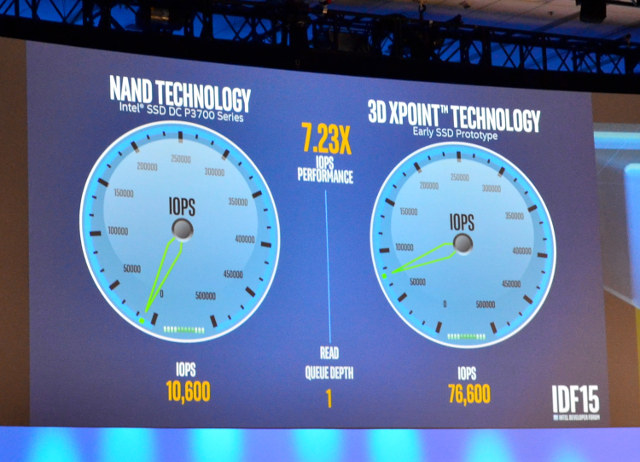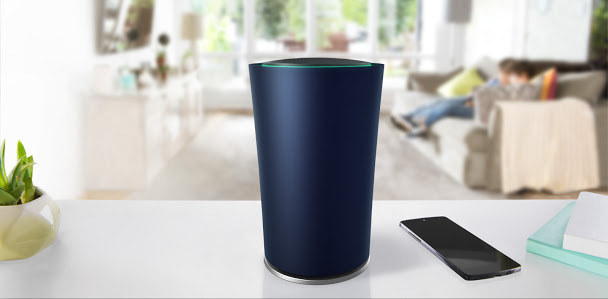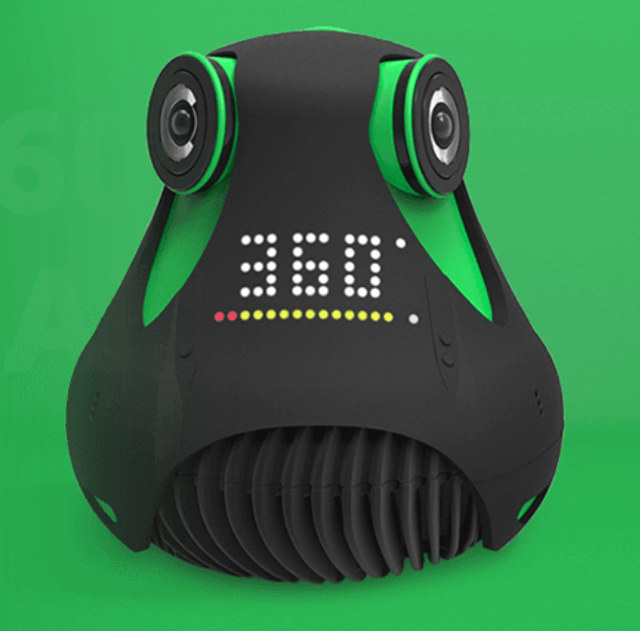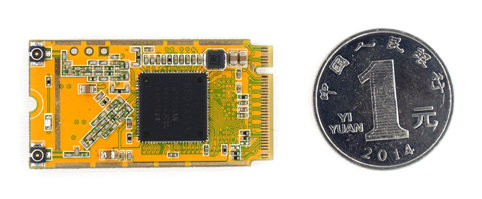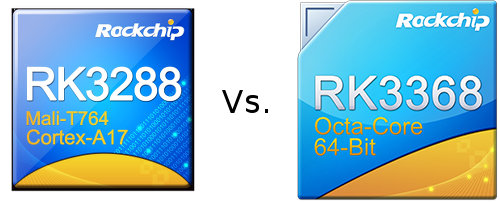Last month, Intel and Micron unveiled 3D XPoint technology – pronounced 3D Crosspoint – promising over 1,000 times the performance and durability of NAND flash, and 10 times the density of DRAM for non-volatile memory. Intel has now showcased some of the first products to use that technology with an Optane SSD. At IDF 2015, Intel compared the performance of their high-end P3700 SSD delivering 10,600 IOPS against an early 3D Xpoint “Optane” SSD prototype that could deliver 76,600 IOPS or 7.23 times more I/O per seconds, while according to Anandtech some other tests still ran 5 times faster on 3D Xpoint compared the NAND based SSD. Intel plans to release 3D XPoint SSD in 2016, as well as 3D Xpoint DIMM modules for the datacenters. These are exciting developments, but it will probably take a few more years before it comes affordable for consumer devices, as a 400GB P3700 […]
Google OnHub 802.11ac WiFi Router Also Supports Bluetooth 4.0, Zigbee/Thread, and Automatic Firmware Upgrades
Google has just announced OnHub, a $200 router designed in cooperation with TP-Link which the company claims will be “fast, secure, and easy to use”. It should indeed be fast as it’s a Class AC1900 router capable of 600 Mbps with 802.11n and 1300 Mbps with 802.11ac. Router are gateways between home networks and the Internet, but most of them aren’t updated automatically, leaving them vulnerable to attacks, while OnHub should get its firmware regularly updated over-the-air and include a Trusted Platform Module (TPM), making it more secure. Finally, Android and iOS apps are available to easily manage the router. OnHub (TGR1900) router specifications: WiSoC – Qualcomm Atheros IPQ8064 dual core Krait processor @ 1.4 GHz System Memory – 1GB DDR3L Storage – 4GB eMMC, 8MB NOR flash Connectivity 802.11 b/g/n 3×3 with smart antenna 802.11 a/n/ac 3×3 with smart antenna AUX wireless (802.11 a/b/g/n/ac 1×1) – I don’t understand […]
$5 Amazon Dash Buttons Can Be Hacked as WiFi Logging Buttons
Amazon launched Dash buttons earlier this year in order to allow Amazon Prime customers to order products by simply pressing them. The small WiFi enabled buttons only cost $5, and looked like a nice thing to hack. And that’s exactly what Ted Benson did, and managed to use them to log his baby’s patterns like the number of time he poos, or wakes up at night by pressing some buttons, and storing the results in a spreadsheet. The hack does not involve any firmware or hardware modifications, and instead he noticed that the Dash was disconnected and sleeping, except when the button was pressed. So all he does is to detect ARP requests from the Dash using some Python code relying on Scapy library, and when the MAC address matches one of the dash MAC addresses (hard coded in the Python program), data is sent to a Google Spreadsheet using […]
Android 6.0 Marshmallow SDK & Final M Preview Released
Google have finally announced Android 6.0 will be Marshmallow, and more importantly released the Android 6.0 SDK (the API won’t change), and the final M Developer Preview. That means developers can already work on and publish apps to the Google Play Store that are compatible with Android 6.0 API level 23. The final Android 6.0 SDK and Android Support Library v23 can be downloaded via the SDK Manager in Android Studio. The new Android Support library includes new libraries such customtabs, percent, recommendation, preference-v7, preference-v14, and preference-leanback-v17, and will help developer integrate new Android Marshallow functionalities to their app in a backward-compatible way. Android 6.0 adds new features like fingerprint scanner support and Doze power saving mode, as well as a new way to handle permissions, but the latest developer preview only brings small changes: Final Permissions User Interface – Updated permissions user interface and permissions behavior. API Change – […]
Meet the First Affordable 360 Degrees Cameras: Gyroptic 360Cam and IC Realtech ALLIe
Last year, I discovered one company developing and selling 360 degrees video recording solutions, and you could then watch the videos using a VR Kit like vrAse, Google Cardboard, or Oculus Rift. It was all cool, but involved a camera mount for 6 GoPro cameras with a total cost well over $2,000. This year, GoPro also unveiled their own camera array for 16 GoPro cameras, again very cool, but even less affordable to the masses. But thanks to two CES 2015 videos recently uploaded to ARMdevices.net, I found out about two interesting sub $500 cameras that can record 360 degrees videos at 1080p, which can then be optionally uploaded to YouTube 360˚, and watched with a VR Kit, using a tablet, or on a touchscreen enabled video sphere. Gyroptic 360 Camera The cool looking 360 degrees camera comes with 3 lenses, a Nike+ Fuelband like display, WiFi or Ethernet connectivity […]
WRTnode2P, WRTnode2R and WRTnodeHi OpenWRT Boards to Feature M.2 & mini PCIe Edge Connectors, H.265 Camera Support, and More
WRTnode is a small and low cost development board powered by Mediatek MT7620N and running OpenWRT. The developers have been working on three new OpenWRT boards based on Mediatek or Hisilicon processor and featuring either an M.2 connector, a mini PCIe connector, or support for H.265 camera. The first board is WRTnode2P with the following specifications: SoC – Mediatek MT7628an MIPS 24KEc processor @ 575 MHz System Memory – 256 MB RAM Storage – 32MB Flash Connectivity – 802.11 b/g/n WiFi @ 300 Mbps (2T2R) I/Os via NGFF M.2 connector: PCIe X1, USB 2.0 host, SD-XC 5x 100M Ethernet switch I2S up to 192K/24-bit 2x UART, SPI, I2C 20x GPIO Dimensions – 42 x 22mm The second board, WRTNode2R, features a processor and a micro-controller, and can be connected to a mini PCIe port: SoC – Mediatek MT7688an MIPS24K Processor @ 580 MHz System Memory – 256 MB DDR2 Storage […]
Rockchip RK3288 vs RK3368 Benchmarks Comparison
Rockchip RK3368 TV boxes are now shipping, and I’ve just reviewed Beelink i68, so it’s a good time to compare the latest octa-core Cortex A53 processor with its predecessor, RK3288, featuring four ARM Cortex A17 cores, as well as a Mali-T764 GPU. To compare both processors, I’ve used Antutu 5.x, Vellamo 3.x and 3DMark Ice Storm Extreme benchmarks results for Beelink i68 (RK3368) and Tronsmart Orion R28 (RK3288). The ratio divides the scores, and a ratio greater than 1 indicates RK3368 outperforms RK3288. Rockchip RK3288 Rockchip RK3368 Ratio CPU Quad core Cortex A17 @ 1.8 GHz Octa core Cortex A53 @ 1.2GHz GPU ARM Mali-T764 PowerVR G6110 Antutu 5.x Overall 36865 34171 0.93 Multitask 5753 4041 0.70 Runtime 1976 2949 1.49 RAM Ops 2475 2346 0.95 RAM Speed 3153 2601 0.82 CPU Integer (multi-thread) 2433 2973 1.22 CPU float-point (multi-thread) 3565 2930 0.82 CPU Integer (single thread) 1432 1536 1.07 […]
Beelink i68 (Rockchip RK3368) TV Box Review
Beelink i68 is one of the first 64-bit ARM Android mini PCs available on the market, and could offer an update to Rockchip RK3288 TV boxes thanks to its eight Cortex A53 cores and support for HDMI 2.0 up to 4K2K @ 60Hz. I’ve already taken a few pictures of the device and RK68 board, so today I’ll report about performance, stability, features and video playback capabilities in the full review. First Boot, Settings and First Impressions The box has three USB 2.0 host ports and a micro USB OTG port, so for once I did not have to use a USB hub to connect all my devices and cables. I’ve inserted an Ethernet cable, an HDMI cable, an optical cable to the S/PDIF output, a Class 10 micro SD card, a USB hard drive, a USB webcam, an RF dongle for Tronsmart Mars G01 wireless gamepad, and finally MeLE […]


